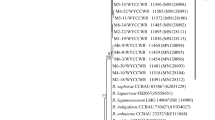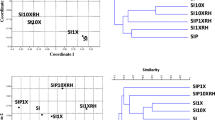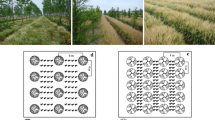Abstract
Denaturing Gradient Gel Electrophoresis (DGGE) was used to study the impact of rhizobial inoculants on the rhizosphere bacterial communities of three medicinal legumes: Indigofera tinctoria, Pueraria mirifica and Derris elliptica Benth. Rhizosphere soils were collected from these legumes grown naturally in 11 provinces of Thailand. The host-specific rhizobial strains were inoculated to their hosts planted in the collected rhizosphere soils of each legume. Four months after planting, total bacterial communities DNA was extracted from the uninoculated rhizosphere soils and the inoculated rhizosphere soils. DGGE fingerprints of PCR-amplified 16S rDNA were obtained from the bacterial communities. PCR-DGGE analysis showed that the bacterial community structures in native rhizospheres of the three legumes were different from each other based on the generated dendrogram and Sorensen’s index. These results suggest that different plant species and soil characteristics synergically affected the rhizosphere bacterial communities. The bacterial diversity of I. tinctoria and P. mirifica native rhizospheres were significantly different from that of D. elliptica Benth. native rhizosphere. Our results also showed that the inoculants contributed to the slight changes in rhizosphere community structures. In comparison with each other, the plants appeared to have a much stronger influence on the bacterial communities rather than the inoculants. Hierarchical cluster analysis revealed that the community structure of the inoculated rhizosphere of D. elliptica Benth. was more divergent from those of inoculated rhizospheres of I. tinctoria and P. mirifica. The ribotype richness which indicates species diversity, was highest in I. tinctoria rhizosphere, followed by P. mirifica rhizosphere and D. elliptica Benth. rhizosphere, respectively.


Similar content being viewed by others
References
Amann RI, Ludwig W, Schleifer KH (1995) Phylogenetic identification and in situ detection of individual microbial cells without cultivation. Microbiol Rev 59:143–169
Bakasso S, Lamien-Meda A, Lamien CE, Kiendrebeogo M, Millogo J, Ouedraogo AG, Nacoulma OG (2008) Polyphenol contents and antioxidant activities of five Indigofera species (Fabaceae) from Burkina Faso. Pak J Biol Sci 11:1429–1435
Bergsma-Vlami M, Prins ME, Staats M, Raaijmakers JM (2005) Assessment of genotypic diversity of antibiotic-producing Pseudomonas species in the rhizosphere by denaturing gradient gel electrophoresis. Appl Environ Microbiol 71:993–1003
Broughton WJ, Dilworth MJ (1971) Control of leghaemoglobin syntheisis in snake beans. Biochem J 125:1075–1080
Carelli M, Gnocchi S, Fancelli S, Mengoni A, Paffetti D, Scotti C, Bazzicalupo M (2000) Genetic diversity and dynamics of Sinorrhizobium meliloti populations nodulation different alfalfa cultivars in Italian soils. Appl Environ Microbiol 66:4785–4789
Costa R, Götz M, Mrotzek N, Lottmann J, Berg G, Smalla K (2006) Effects of site and plant species on rhizosphere community structure as revealed by molecular analysis of microbial guilds. FEMS Microbiol Ecol 56:236–249
Diallo MD, Willems A, Vloemans N, Cousin S, Vandekerckhove TT, de Lajudie P, Neyra M, Vyverman W, Gillis M, van der Gucht K (2004) Polymerase chain reaction denaturing gradient gel electrophoresis analysis of the N2-fixing bacterial diversity in soil under Acacia tortilis ssp. raddiana and Balanites aegyptiaca in the dryland part of Senegal. Environ Microbiol 6:400–415
Estrada SRT, Sepulveda IR, Crawford DL (1998) In vitro and in vivo antagonism of Streptomyces violaceusinger YCED9 against fungal pathogens on turf grass. World J Microbiol Biotechnol 14:865–872
Felske A, Osborn AM (2005) DNA fingerprint of microbial communities. In: Osborn AM, Smith CJ (eds) Molecular microbial ecology, 1st edn. Taylor and francis group, NY, pp 65–90
Glick BR (1995) The enhancement of plant growth by free living bacteria. Can J Microbiol 41:109–114
Han R (1994) Highlight on the studies of anticancer drugs derived from plants in China. Stem Cells 12:53–63
Heuer H, Krsek M, Baker P, Smalla K, Wellington EMH (1997) Analysis of actinomycete communities by specific amplification of genes encoding 16S rRNA and gel-electrophoretic separation in denaturing gradients. Appl Environ Microbiol 68:3233–3241
Hill GT, Mitkowski NA, Aldrich-Wolfe L, Emele LR, Jurkonie DD, Ficke A, Maldonado-Ramirez S, Lynch ST, Nelson EB (2000) Methods for assessing the composition and diversity of soil microbial communities. Appl Soil Ecol 15:25–36
Kaksonen AH, Jussila MM, Lindström K, Suominen L (2006) Rhizosphere effect of Galega orientalis in oil-contaminated soil. Soil Biol Biochem 38:817–827
Kandeler E, Tscherko D, Bruce KD, Stemmer M, Hobbs PJ, Bardgett RD, Amelung W (2000) Structure and function of the soil microbial community in microhabitats of a heavy metal polluted soil. Soil Biol Biochem 32:390–400
Keele BB Jr, Hamilton PB, Elkan GH (1969) Glucose catabolism in Rhizobium japonicum. J Bacteriol 97:184–191
Kloepper JW, Lifshitz R, Zablotowicz RM (1989) Free-living bacterial inocula for enhancing crop productivity. Trends Biotechnol 7:39–43
Kotani-tanoi T, Nishitama M, Otsuka S, Senoo K (2007) Single particle analysis reveals that bacterial community structures are semi-specific to the type of soil particle. Soil Sci Plant Nutr 53:740–743
Lioussanne L, Perreault F, Jolicoeur M, St-Arnaud M (2010) The bacterial community of tomato rhizosphere is modified by inoculation with arbuscular mycorrhizal fungi but unaffected by soil enrichment with mycorrhizal root exudates or inoculation with Phytophthora nicotianae. Soil Biol Biochem 42:473–483
Lui C, Yang JL, Wu G, Zhang S, Li ZX, Guo JB (2010) Estimation of dominant microbial population sizes in the anaerobic granular sludge of a full-scale UASB treating streptomycin wastewater by PCR-DGGE. World J Microbiol Biotechnol 26:375–379
Marschner P, Yang CH, Lieberei R, Crowley DE (2001) Soil and plant specific ettects on bacterial community composition in the rhizosphere. Soil Biol Biochem 33:1437–1445
Marschner P, Crowley D, Yang CH (2004) Development of specific rhizosphere bacterial communities in relation to plant species, nutrition and soil type. Plant Soil 261:199–208
Merckx R, Dijkra A, Hartog AD, van Veen JA (1987) Production of root-derived material and associated microbial growth in soil at different nutrient levels. Biol Fertil Soils 5:126–132
Nakatsu CH, Torsvik V, Øvreås L (2000) Soil community analysis using DGGE of 16S rDNA polymerase chain reaction production. Soil Sci Soc Am J 64:1382–1388
Nikolcheva LG, Cockshutt AM, Bärlocher F (2003) Determining diversity of freshwater fungi on decaying leaves: comparison of traditional and molecular approaches. Appl Environ Microbiol 69:2548–2554
Okamura S, Sawada Y, Satoh T, Sakamoto H, Saito Y, Sumino H, Takizawa T, Kogure T, Chaichantipyuth C, Higuchi Y, Ishikawa T, Sakamaki T (2008) Pueraria mirifica phytoestrogens improve dyslipidemia in postmenopausal women probably by activating estrogen receptor subtypes. Tohoku J Exp Med 216:341–351
Palasuwan A, Soogaran S, Lertlum T, Pradniwat P, Wiwanitkit V (2005) Inhibition of Heinz body induction in an in vitro model and total antioxidant activity of medicinal Thai plants. Asian Pac J Cancer Prev 6:458–463
Rovira A (1956) Plant root excretions in relation to rhizosphere effect. I. The nature of root exudates from oats and peas. Plant Soil 7:178–194
Schwieger F, Tebbe CC (2000) Effect of field inoculation with Sinorhizobium meliloti L33 on the composition of bacterial communities in rhizosphere of a target plant (Medicago sativa) and non-target plant (Chenopodium album)-linking of 16S rRNA gene-based single stand conformation polymorphism community profiles to the diversity of cultivated bacteria. Appl Environ Microbiol 66:3556–3565
Silvestri G, Santarelli S, Aquilanti L, Beccaceci A, Osimani A, Tonucci F, Clementi F (2007) Investigation of the microbial ecology of Ciauscolo, a traditional Italian salami, by culture-dependent techniques and PCR-DGGE. Meat Sci 77:413–423
Smalla K, Wieland G, Buchner A, Zock B, Parzy J, Kaiser S, Roskot N, Heuer H, Berg G (2001) Bulk and rhizosphere soil bacterial communities studied by denaturing gradient gel electrophoresis: plant-dependent enrichment and seasonal shifts revealed. Appl Environ Microbiol 67:4742–4751
Sorensen T (1948) A method of establishing groups of equal amplitude in plant society based on similarity of species content. K Danske Vidensk Selsk 5:1–34
Sreepriya M, Devaki T, Balakrishna K, Apparanantham T (2001) Effect of Indigofera tinctoria Linn. on liver antioxidant defense system during D-galactosa mine/endotoxin-induced acute hepatitis in rodents. Indian J Exp Biol 39:181–184
Van Dillewijn P, Villadas PJ, Toro N (2002) Effect of a Sinorhizobium meliloti strain with a modified putA gene on the rhizosphere microbial community of alfafa. Appl Environ Microbiol 68:4201–4208
Zaady E, Ben-David EA, Sher Y, Tzirkin R, Nejidat A (2010) Inferring biological soil crust successional stage using combined PLFA, DGGE, physical and biophysiological analyses. Soil Biol Biochem 42:842–849
Acknowledgements
This work was supported by the TRF/BIOTEC Special Program for Biodiversity Research and Training grant R-152080. We thank Dr. Achara Nuntagij for providing soil samples and strains and Chonchanok Leelahawonge for her assistance on planting.
Author information
Authors and Affiliations
Corresponding author
Rights and permissions
About this article
Cite this article
Nimnoi, P., Lumyong, S. & Pongsilp, N. Impact of rhizobial inoculants on rhizosphere bacterial communities of three medicinal legumes assessed by denaturing gradient gel electrophoresis (DGGE). Ann Microbiol 61, 237–245 (2011). https://doi.org/10.1007/s13213-010-0128-y
Received:
Accepted:
Published:
Issue Date:
DOI: https://doi.org/10.1007/s13213-010-0128-y




